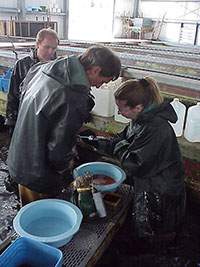Diquat
INAD #10-969
Drug Name Method of Administration Required INAD Fee Drug Source Turf Landscape and Pest Customer Service AADAP Contact |
![]()
Drug History and Summary
Diseases of cultured fish can result in high fish mortality which can ultimately impact fish stocking programs, fisheries management projects, and commercial fish farms. There are a number of diseases that have become problematic at aquaculture facilities across the country, but a few, including bacterial gill disease (BGD), columnaris, and coldwater disease (CWD), appear to be the most prevalent.
- Bacterial gill disease is one of the most serious diseases of intensively cultured fish, particularly among young salmonids. If BGD is not diagnosed and treated early, significant mortality may occur in a very short period of time. Fish mortality is generally not a direct result of the infection, but is a consequence of the infection (i.e., structural changes in gill morphology). Stressors associated with intense fish culture may predispose fish to such an infection. Clinical signs of BGD have been well documented, and it is widely known that this disease can cause the rapid proliferation of gill epithelium and the production of excess mucus as the host responds defensively to the infection. This response can “smother” gills and result in severe fish losses if prompt measures are not taken. If BGD, which is horizontally transmitted, is not diagnosed and treated early, an epizootic may occur within a 24-h period (Bullock et al. 1990).
- Columnaris – although Flavobacterium branchiophilum is suspected as the bacteria responsible for causing most outbreaks of BGD (Wakabayashi, et al., 1989; Ferguson et al., 1991), other gram-negative bacteria have also been implicated. These “other” bacteria include pathogens such as F. aquatile, F. psychrophilum (causative agent of CWD), and F. columnare (causative agent of columnaris). Columnaris disease has been reported to cause significant mortality in a wide variety of fish, and is particularly devastating to cool and warm water species. Although the optimum temperature for the occurrence of columnaris disease is approximately 28 – 30oC, epizootics often occur in cultured fishes at 10 – 17oC. This pathogen typically first invades the skin of the head region, including the mouth, lips, cheeks, and gills and can result in necrosis of gill tissue. The pathogen also invades injuries or open wounds on the body of the fish. Although F. columnare can routinely be detected externally in moribund fish when specimens are collected from the gills or open wounds of infected fish, the pathogen can also be cultured from kidney tissue of seriously infected fish. In such cases, columnaris disease is usually terminal within a relatively short period of time (Post 1987).
Historically, several chemicals including benzalkonium chloride (available as Hyamine 1622 and 3500), diquat, hydrogen peroxide, and chloramine-T have been used to control mortality caused by BGD (Bullock et al. 1990) and other external flavobacteria. Currently, Halamid Aqua (100% chloramine-T) and 35% Perox Aid (35% hydrogen peroxide) are the only compounds approved by the FDA to control mortality in freshwater-reared salmonids due to BGD. In addition, Halamid Aqua is approved to control mortality of walleye and all freshwater-reared warm water finfish due to external columnaris disease, and 35% Perox Aid is approved to control mortality in all coolwater finfish and channel catfish due to external columnaris disease. Although it has been demonstrated that both drugs are effective in controlling mortality due to BGD and columnaris, there is ancillary data (i.e., INAD records) that show diquat is more effective than either Halamid Aqua or 35% Perox Aid in some instances. The success of diquat that effectively controls mortality caused by external flavobacteria has been attributed to its characterization as a non-selective sanitizing agent that effectively cleans up external fish surfaces, including skin and gills infested with bacteria.
The primary goal of field studies conducted under INAD #10-969 is to generate data to help determine appropriate diquat treatment regimens for controlling mortality in a variety of cultured fishes diagnosed with BGD or external flavobacteriosis. Syngenta Crop Protection, Inc., will be the sole supplier of diquat to all Investigators. Under this INAD, two treatment regimens will be allowed, and withdrawal time will vary with species and treatment regimen. No prophylactic or preventive use of Diquat is allowed under this INAD.
Please see the diquat study protocol for all cited references.
![]()
ObjectiveCollect supportive and pivotal data needed to establish the effectiveness of diquat to control mortality caused by certain bacterial diseases. Target Pathogen(s)External flavobacteriosis (e.g., bacteria responsible for bacterial gill disease and external columnaris) Required Test ParametersInvestigator must collect mortality data throughout the 5-day pre-treatment, treatment, and 10-day post-treatment periods. Investigator should also report general fish behavior and any adverse effects relating to treatment. Restrictions on UseProphylactic (preventive) treatment of fish is not allowed. Treatment Dosage2 - 18 milligram (mg) Diquat per liter 19 - 28 milligram (mg) Diquat per liter Treatment Regimen1 - 4 hour treatment; 1 - 4 treatments on alternate or consecutive days 30 - 60 minute treatment; 1 - 3 treatments on alternate days Withdrawal Period5 days for adult Ictaluridae and Esocidae 30 days for all other species No holding time is assigned for fish that have a grow-out period that exceeds 30 days. The investigational withdrawal periods may be incorporated into the grow-out period. Data Collection and ReportingThe following drug forms are intended primarily to provide Investigators a guide as to the type of data that must be collected during a study. In some cases, Investigators may deem the forms appropriate for the collection of raw data. However, it is extremely important to note that all data must be entered (and submitted) using the INAD Program Management System (online database). Drug Forms
Product and company names mentioned in this website, or mentioned in materials accessed via this website, are for informational purposes only. The mention of such does not imply endorsement by the Aquatic Animal Drug Approval Partnership, the U.S. Fish & Wildlife Service or any other organization of the U.S. Government. |



